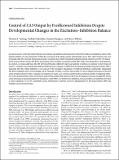| dc.contributor.author | Torborg, Christine L. | |
| dc.contributor.author | Nakashiba, Toshiaki | |
| dc.contributor.author | Tonegawa, Susumu | |
| dc.contributor.author | McBain, Chris J. | |
| dc.date.accessioned | 2011-07-28T15:21:02Z | |
| dc.date.available | 2011-07-28T15:21:02Z | |
| dc.date.issued | 2010-11 | |
| dc.date.submitted | 2010-09 | |
| dc.identifier.issn | 0270-6474 | |
| dc.identifier.issn | 1529-2401 | |
| dc.identifier.uri | http://hdl.handle.net/1721.1/64966 | |
| dc.description.abstract | In somatosensory cortex, the relative balance of excitation and inhibition determines how effectively feedforward inhibition enforces the
temporal fidelity of action potentials. Within the CA3 region of the hippocampus, glutamatergic mossy fiber (MF) synapses onto CA3
pyramidal cells (PCs) provide strong monosynaptic excitation that exhibit prominent facilitation during repetitive activity. We demonstrate
in the juvenile CA3 that MF-driven polysynaptic IPSCs facilitate to maintain a fixed EPSC-IPSC ratio during short-term plasticity.
In contrast, in young adult mice this MF-driven polysynaptic inhibitory input can facilitate or depress in response to short trains of
activity. Transgenic mice lacking the feedback inhibitory loop continue to exhibit both facilitating and depressing polysynaptic IPSCs,
indicating that this robust inhibition is not caused by the secondary engagement of feedback inhibition. Surprisingly, eliminating
MF-driven inhibition onto CA3 pyramidal cells by blockade of GABAA [GABA subscript A] receptors did not lead to a loss of temporal precision of the first
action potential observed after a stimulus but triggered in many cases a long excitatory plateau potential capable of triggering repetitive
action potential firing. These observations indicate that, unlike other regions of the brain, the temporal precision of single MF-driven
action potentials is dictated primarily by the kinetics of MF EPSPs, not feedforward inhibition. Instead, feedforward inhibition provides
a robust regulation of CA3 PC excitability across development to prevent excessive depolarization by the monosynaptic EPSP and
multiple action potential firings. | en_US |
| dc.description.sponsorship | Eunice Kennedy Shriver National Institute of Child Health and Human Development (U.S.) | en_US |
| dc.description.sponsorship | Pharmacology Research Associate Program | en_US |
| dc.description.sponsorship | National Institutes of Health (U.S.) (Grant R01-MH078821) | en_US |
| dc.description.sponsorship | National Institutes of Health (U.S.) (Grant P50-MH58880) | en_US |
| dc.language.iso | en_US | |
| dc.publisher | Society for Neuroscience | en_US |
| dc.relation.isversionof | http://dx.doi.org/10.1523/jneurosci.3099-10.2010 | en_US |
| dc.rights | Article is made available in accordance with the publisher's policy and may be subject to US copyright law. Please refer to the publisher's site for terms of use. | en_US |
| dc.source | SFN | en_US |
| dc.title | Control of CA3 Output by Feedforward Inhibition Despite Developmental Changes in the Excitation-Inhibition Balance | en_US |
| dc.type | Article | en_US |
| dc.identifier.citation | Torborg, C. L. et al. “Control of CA3 Output by Feedforward Inhibition Despite Developmental Changes in the Excitation-Inhibition Balance.” Journal of Neuroscience 30.46 (2010) : 15628-15637. Copyright © 2010 the authors | en_US |
| dc.contributor.department | Massachusetts Institute of Technology. Department of Biology | en_US |
| dc.contributor.department | Picower Institute for Learning and Memory | en_US |
| dc.contributor.department | RIKEN-MIT Center for Neural Circuit Genetics | en_US |
| dc.contributor.approver | Tonegawa, Susumu | |
| dc.contributor.mitauthor | Nakashiba, Toshiaki | |
| dc.contributor.mitauthor | Tonegawa, Susumu | |
| dc.relation.journal | Journal of Neuroscience | en_US |
| dc.eprint.version | Final published version | en_US |
| dc.type.uri | http://purl.org/eprint/type/JournalArticle | en_US |
| eprint.status | http://purl.org/eprint/status/PeerReviewed | en_US |
| dspace.orderedauthors | Torborg, C. L.; Nakashiba, T.; Tonegawa, S.; McBain, C. J. | en |
| dc.identifier.orcid | https://orcid.org/0000-0003-2839-8228 | |
| mit.license | PUBLISHER_POLICY | en_US |
| mit.metadata.status | Complete | |
